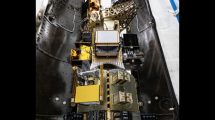
In-orbit servicing will revolutionise satellite operations in MEA and beyond, writes Arie Halsband, founder and CEO of Effective Space.
In the past decade, satellite operators have suffered a series of anomalies. Spacecom, for example, lost contact with its AMOS-5 satellite stationed in geostationary orbit over Africa, while a multi-million-dollar Nigerian satellite had to be shut down a little over a year after its launch, to prevent it spinning out of control and damaging others in orbit. This year, it was revealed that the Al-Yah 3 satellite had been launched into the wrong orbit, forcing it to lose over a third of its expected lifespan to reach operational orbit. The error was undoubtedly a costly one; it is predicted to result in a circa $78 million insurance claim. Careful and devoted engineering efforts allowed it to eventually reach operational orbit.
With satellites costing hundreds of millions of dollars to put into orbit, even the slightest mishap can lead to significant unexpected costs. And if a mistake should occur, satellite operators’ options have historically been limited: retire the satellite early, endure extensive costs trying to rectify the mistake, or risk dangerous consequences.
This landscape is one of the key drivers behind the development of in-orbit servicing. In 2014, the US military’s Defense and Advanced Research Projects Agency stated that “the ability to safely and cooperatively interact with satellites in GEO would immediately revolutionise military and commercial space operations alike, lowering satellite construction and deployment costs and improving satellite lifespan, resilience and reliability”, and since then momentum for the technology has surged. In January this year, market research firm Northern Sky Research concluded in its ‘In-Orbit Servicing Markets’ report that by 2028 the market will be worth $3bn, with life extension driving much of this revenue.
Satellite servicing technologies enable space assets to be serviced, delivered, maintained, monitored and guaranteed in orbit and beyond. However, while the advantages of in-orbit servicing are clear, it has only become a reality thanks to recent technological advancements. One critical challenge that had to be overcome was the creation of a viable servicing spacecraft that could be built, launched and operated at the fraction of a traditional satellite’s cost. Why would anyone pay for a servicing spacecraft if its cost was the same as buying and launching a replacement satellite? The servicing spacecraft must contain enough fuel to serve its multiple customers; be able to operate for many years; power its own systems; rendezvous and dock with the host satellite; act as an additional propulsion system carrying out the necessary manoeuvres (station-keeping and attitude control); and, if needs arise, relocate or de-orbit the satellite.
To address this challenge, forward-thinking satellite operators are looking to use external ‘jet-pack’ solutions which can be about the size of a household washing machine. These use electric propulsion, with a substantial supply of onboard propellant, to manoeuvre. This fuel is used to reach the host satellite for station-keeping and attitude control. Further service could include moving a satellite to a new orbital slot.
Earlier in the year, we signed a $100m contract with a major regional satellite operator, which will see two SPACE DRONE spacecraft launched into orbit in 2020, to significantly extend the life of two communication satellites. Anticipated future services include support for low-Earth and medium-low-Earth orbit constellations, active debris removal, in-space explorations, mining and manufacturing logistics. Life extension and in-orbit services are crucial tools that can be used to manage future fleets and assets and ensure commercially viable services. With more than 400 satellites currently in geosynchronous Earth orbit and thousands expected to be deployed in low-Earth orbit, the market opportunities are considerable.












Add Comment